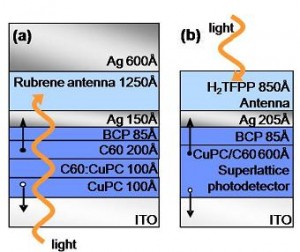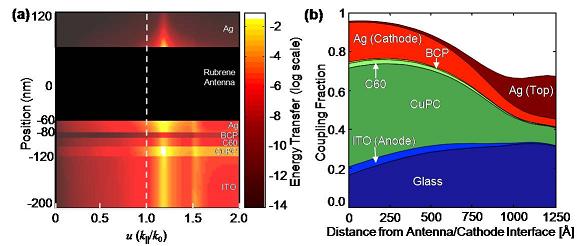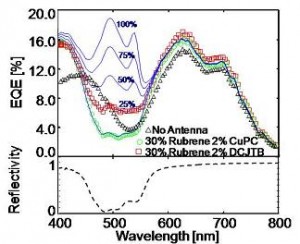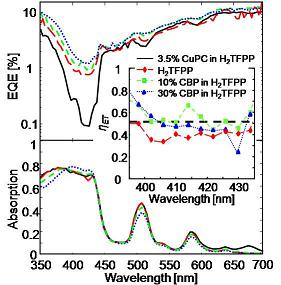Research
Surface plasmon polariton mediated energy transfer in organic photovoltaic devices
T.D. Heidel, J.K. Mapel, K. Celebi, M.A. Baldo
Sponsorship: DARPA/AFOSR, NSF Nanoscale Interdisciplinary Research Team
Organic PVs are constrained by a tradeoff between exciton diffusion and optical absorption. The short exciton diffusion length within organic semiconductors demands the use of extremely absorptive materials. Unfortunately, the excitonic character of most organic materials yields highly structured absorption spectra, with regions of strong and weak absorption.
We propose a device architecture that boosts the performance of a phthalocyanine-based PV in the absorption gap between the phthalocyanine Q and Soret bands. Light absorption is decoupled from exciton diffusion using a light-absorbing “antenna” layer external to the conventional charge generating layers, see Fig. 1. Radiation absorbed by the antenna is transferred into the charge generating layers via surface plasmon polaritons (SPP) in an interfacial thin silver contact. Off resonance, the antenna cavity operates as a reflector and all devices exhibit identical performance. However, in the region where the cavity is tuned to absorb light strongly, the devices with antennas exhibit increased quantum efficiency.
Fig. 1 (a) Devices with resonant antenna cavities have the structure: glass/ indium tin oxide (ITO) (1100 Å)/ copper phthalocyanine (CuPC) (100Å)/ CuPC:fullerene (C60) (1:1) (100Å)/ C60 (200Å) / bathocuproine (BCP) (85Å)/ Ag (150Å)/ 30% Rubrene in carbazole biphenyl (CBP) antenna (1250Å) / Ag (600Å). (b) For measurement of energy transfer efficiency, high internal quantum efficiency superlattice photodetectors are used with the structure: glass/ ITO (1100Å)/ 20 alternating layers of CuPC and 3,4,9,10-perylenetetracarboxylic bisbenzimidazole (PTCBI) (each layer 15Å)/ BCP(85Å)/ Ag (205Å)/ 5,10,15,20-tetrakis(pentafluorophenyl)porphyrin (H2TFPP) (850Å).
We model energy transfer within a multilayer organic PV stack by evaluating the Poynting vector, P, using dyadic Green’s functions. The wavevector dependence of energy transfer from the antenna to the PV is shown in Fig. 2a. We find that energy transfer occurs predominantly via non-radiative coupling, mediated by SPP modes with u > 1. We also model the dipole coupling efficiency to each layer in the PV stack as a function of the dipole distance from the antenna/cathode interface, see Fig. 2b. Near the cathode the energy transfer efficiency is 54%, but the efficiency decreases beyond ~85nm. Averaged over the antenna, the efficiency of transfer is 31%.
Fig. 2 (a)The normalized in-plane wavevector (u) dependence of energy transfer throughout the resonant cavity devices is shown for dipoles oriented perpendicular to the antenna/cathode interface. Coupling is greatest for dipoles into modes with u>1, corresponding to surface plasmon polaritons (SPPs). (b) The modeled dipole coupling fraction to each layer in the photovoltaic stack as a function of the dipole distance from the antenna/cathode interface. Coupling to the CuPC and C60 layers results in photocurrent.
We experimentally compare a control device without the antenna to devices with an antenna composed of 30% Rubrene and 2% laser dye 4-(dicyanomethylene)-2-t-butyl-6-(1,1,7,7-tetramethyljulolidyl-9-enyl)-4H-pyran (DCJTB) in CBP. Quenched antennas were also fabricated with the addition of 2% of the quenching material CuPC instead of DCJTB. The external quantum efficiencies of these devices as a function of wavelength are shown in Fig. 3 and compared to the reflectivity of the antenna cavity. Using the absorption of the antenna and the internal quantum efficiency at the PL maximum of DCJTB, we determine the energy transfer efficiency to be (25±10)%, consistent with the calculated result of energy transfer efficiency of 31% found above. As illustrated, with improved energy transfer, the efficiency in the spectral gap between absorption peaks could be significantly improved.
Fig. 3 External quantum efficiency (EQE) for resonant antenna devices. Devices with functional external rubrene-based antenna layers exhibit an increase in EQE over the wavelength range where rubrene absorption occurs and the cavity reflectivity decreases. The functional antenna (□) shows a significant performance enhancement versus both the quenched antenna (○) and devices fabricated without any antenna (Δ). Comparison with modeling (—) indicates that the energy transfer efficiency is approximately 25%. We also show the expected EQE for energy transfer efficiencies of 0%, 50%, and 75%.
To reduce the uncertainties in the measurement of the efficiency of energy transfer, we fabricate an organic superlattice photodetector with IQE ~ 100% under applied bias and antenna without the resonant cavity. This structure should also enhance the energy transfer efficiency, since it contains more CuPC, increasing the absorption of SPPs in the charge generating layers. We choose tetrakis(pentafluorophenyl)porphyrin (H2TFPP) as a highly absorptive antenna material with moderate PL efficiency. The measured absorption and PL efficiency of the H2TFPP antenna is used to determine the energy transfer efficiency from the increase in external quantum efficiency. We find the energy transfer efficiency to be (51±10)%, substantially higher than the resonant antenna result, see the inset of Fig. 4.
Fig. 4 Measurement of energy transfer efficiency using superlattice photodetectors. Top: Measurement of external quantum efficiency of devices with different antenna compositions. Bottom: Absorption spectra of different antenna layers on glass. Inset: Calculation of energy transfer efficiency normalized by the PL efficiencies of the various antennas yields an energy transfer efficiency of (51±10)%.
Energy coupling from external antenna layers into thin film organic PV provides a flexible route to higher efficiency devices. While the introduction of the antenna necessarily adds a step into the energy transduction process, it can be successfully employed in spectral regions where the absorption fraction of the PV cell drops below the SPP-mediated energy transfer efficiency. We measured this latter efficiency to be at least (51±10)%. It is possible to increase the quantum efficiency of an antenna to nearly 100% by optimizing the orientation and position of a luminescent dye with respect to a thin Ag film. Targeting resonant antennas to regions of poor absorption promises to solve a characteristic deficiency of organic PVs.
Relevant publications
- T.D. Heidel, J.K. Mapel, K. Celebi, M. Singh, M.A. Baldo, ‘Analysis of surface plasmon polariton mediated energy transfer in organic photovoltaic devices’, Proc. of SPIE, 6656, 66560I1-8, (2007).
- T.D. Heidel, J.K. Mapel, M. Singh, K. Celebi, and M.A. Baldo, ‘Surface plasmon polariton mediated energy transfer in organic photovoltaic devices’, Applied Physics Letters, 91, 093506 (2007).
- J.K. Mapel, K. Celebi, M. Singh, and M.A. Baldo. ‘Plasmonic excitation of organic double heterostructure solar cells.’ Applied Physics Letters 90, 121102 (2007).
- K. Celebi, T.D. Heidel, and M.A. Baldo, ‘Simplified calculation of dipole energy transport in a multilayer stack using dyadic Green’s functions,’ Optics Express 15 (4), 1762-1772 (2007).





